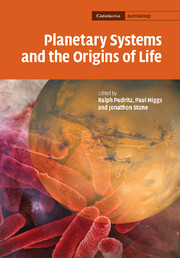Book contents
- Frontmatter
- Contents
- List of contributors
- Preface
- Part I Planetary systems and the origins of life
- Part II Life on Earth
- 6 Extremophiles: defining the envelope for the search for life in the universe
- 7 Hyperthermophilic life on Earth – and on Mars?
- 8 Phylogenomics: how far back in the past can we go?
- 9 Horizontal gene transfer, gene histories, and the root of the tree of life
- 10 Evolutionary innovation versus ecological incumbency
- 11 Gradual origin for the metazoans
- Part III Life in the Solar System?
- Index
10 - Evolutionary innovation versus ecological incumbency
Published online by Cambridge University Press: 13 August 2009
- Frontmatter
- Contents
- List of contributors
- Preface
- Part I Planetary systems and the origins of life
- Part II Life on Earth
- 6 Extremophiles: defining the envelope for the search for life in the universe
- 7 Hyperthermophilic life on Earth – and on Mars?
- 8 Phylogenomics: how far back in the past can we go?
- 9 Horizontal gene transfer, gene histories, and the root of the tree of life
- 10 Evolutionary innovation versus ecological incumbency
- 11 Gradual origin for the metazoans
- Part III Life in the Solar System?
- Index
Summary
The Ediacaran world
The terminal period of the Proterozoic, called Ediacaran after a locality in the Flinders Ranges of South Australia (or Vendian in the Russian terminology), marks the first appearance of undoubted macrofossils. Because they are seemingly complex (and because they have been studied mainly by palaeozoologists), all Ediacaran macrofossils were interpreted originally as early multicellular animals (metazoans). The title of Martin Glaessner's 1984 monumental book, The Dawn of Animal Life, expresses this view. The discovery of similar fossils in approximately 30 localities all over the world further contributed to the assumption that the Ediacaran fauna represents simply a prelude to the Cambrian evolutionary explosion of metazoan phyla. Consequently, the Ediacaran period could be considered as the initial stage of the Palaeozoic.
Subsequently, this view has been challenged by the vendobiont hypothesis (Seilacher, 1984, 1992). The challenge started with the observation that most of these organisms represent hydrostatic ‘pneu’ structures, whose various shapes were maintained by a quilted skin (as in an air mattress) and the internal pressure of the living content. Another feature shared by all vendobionts is the allometric growth of the quilt patterns. No matter whether the addition of new ‘segments’ continued throughout life (serial mode) or stopped at a certain point, followed by the expansion and secondary subdivision of established quilts (fractal mode), compartments never exceed a certain millimetric diameter. Such allometry is common in oversized unicellular organisms, such as certain algae (Acetabularia) and larger Foraminifera.
- Type
- Chapter
- Information
- Planetary Systems and the Origins of Life , pp. 193 - 209Publisher: Cambridge University PressPrint publication year: 2007
- 2
- Cited by



